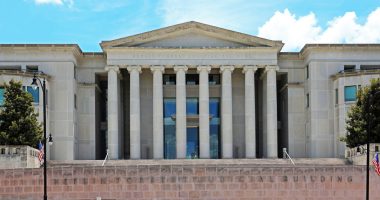With the best job growth in over 40 years, inflation a national obsession and the Federal Reserve preparing to raise interest rates, it is easy to forget how different the world was before the pandemic. The global environment then was marked by sluggish growth, lackluster investment, worryingly low inflation and low interest rates.
Which could be where the U.S. is headed again.
The bond market seems to be betting on it. Even with U.S. inflation at a near-40 year high of 7%, 10-year Treasury yields are below 2%. Real bond yields—that is, adjusted for expected future inflation—are negative 0.2%, and have been mostly negative since the start of the pandemic, only the second such episode in 30 years.
Even as the Fed moves up plans to raise interest rates, markets have revised down how high they are likely to get. They see the federal-funds rate, now near zero, reaching only 2% in 2025, which would be slightly negative in real terms.
Investors, of course, may simply be wrong. Since the start of the year, investors appear to have reassessed the interest-rate outlook. Bonds have sold off, with the 10-year Treasury yield, which moves in the opposite direction to its price, jumping to 1.7% from 1.5% at the end of 2021.

The Federal Reserve building in Washington, D.C. The Fed has moved up plans to raise interest rates, but markets have revised down how high they are likely to get.
Photo: Stefani Reynolds/Bloomberg News
Yet there are good reasons to think today’s sizzling economy may be just a temporary respite. Looked at over the longer term, real yields have been declining for decades. Olivier Blanchard, the former chief economist at the International Monetary Fund, makes this point in a new book, “Fiscal Policy Under Low Interest Rates.” In it he notes that safe interest rates—in other words, those on risk-free government debt—have been declining in the U.S., Western Europe, and Japan for 30 years. “Their decline is due neither to the Global Financial Crisis of the late 2000s, nor to the current Covid crisis, but to more persistent factors,” he writes. “Something has happened in the last 30 years, which is different from the past.”
Several years ago, former Treasury Secretary Larry Summers argued a persistent shortfall of investment amid a glut of global savings was holding down both growth and interest rates, a situation he called “secular stagnation,” a term first used in the 1930s.
“Secular stagnation was the issue of the moment in the late 1930s,” Mr. Summers said at The Wall Street Journal’s CEO Council Summit in December. “Once rearmament and World War II began, and there was a massive fiscal expansion, it was no longer the issue. In the same way, after we’ve had a 15%-of-GDP fiscal expansion, secular stagnation is not the issue of this moment.”
New warnings
That is why early last year Mr. Summers switched from warning about secular stagnation to warning that fiscal and monetary stimulus threatened to send inflation sharply higher. Yet he thinks it more likely than not that secular stagnation will return in a few years’ time: That is a “natural interpretation” of why markets expect real interest rates to remain so low, he said.
Sluggish Signals
Interest rates and demographics indicate that the current moment of high inflation and hot growth may not last

Real 10-Year Treasury yield
Expected federal-funds rate
Peak rate expectations have eased since June
10-year Treasury yield minus the 10-year expected inflation rate*
Day before June FOMC meeting
Inflation-indexed bond yield

Real 10-Year Treasury yield
Expected federal-funds rate
Peak rate expectations have eased since June
10-year Treasury yield minus
the 10-year expected inflation rate*
Day before June
FOMC meeting
Inflation-indexed
bond yield

Real 10-Year Treasury yield
10-year Treasury yield minus the 10-year expected inflation rate*
Inflation-indexed bond yield
Expected federal-funds rate
Peak rate expectations have eased since June
Day before June FOMC meeting

Real 10-Year Treasury yield
10-year Treasury yield minus the 10-year expected inflation rate*
Inflation-indexed bond yield
Expected federal-funds rate
Peak rate expectations have eased since June
Day before June FOMC meeting

Real 10-Year Treasury yield
10-year Treasury yield minus the 10-year expected inflation rate*
Inflation-indexed bond yield
Expected federal-funds rate
Peak rate expectations have eased since June
Day before June FOMC meeting
This possibility also weighs on the minds of Fed officials. Neel Kashkari, president of the Federal Reserve Bank of Minneapolis, said in supporting higher rates this year that he is weighing two opposing risks. One is that high inflation becomes embedded in the public’s behavior, which would require even higher interest rates later on. The other is that after Covid-19 passes, the world returns to the pre-pandemic regime of low growth and low inflation. That regime, he wrote on the publishing site Medium, was driven by “demographics, trade, and technology factors. It is unlikely that these underlying forces have gone away.”
Slower population growth reduces demand for cars, houses and other durable goods, and the need for business to expand capacity. Lengthened life expectancy means people spend more of their lives retired, so they save more in anticipation. In combination, these effects tend to hold down interest rates.
The pandemic intensified the trend of slowing population growth around the world. The U.S. population grew just 0.1% in the year to July—the slowest on record—as both birthrates and immigration plummeted. With retirements accelerating because of the pandemic, the U.S. labor force ended last year 1.4% smaller than before the pandemic.
China’s population barely rose in 2020, and its population in the 15 to 59 age range shrank 5% in the preceding decade. The government has responded with alarm. A state-backed newspaper briefly urged Communist Party members to have more children, and access to vasectomies and abortion has reportedly diminished.
Annual Population Growth Rates
This driver of economic growth has been low and falling in these key economies

European Union

European Union

European Union

European Union

European Union
A hit to productivity
Apart from population, the main contributor to growth is productivity, and that too appears to have suffered during the pandemic. While businesses stepped up digitization by investing more in e-commerce, cloud computing and artificial intelligence, productivity has still suffered because of Covid-19 protocols and restrictions, and sweeping changes in where, and whether, people chose to work. The recent rise in inflation suggests the U.S. can’t grow as fast as before without straining productive capacity. Some of those barriers to growth are likely to persist even after the pandemic passes.
Meanwhile, Chinese investment has slowed under the impact of its own Covid-19 restrictions and cooling property sector. As a result, its excess savings are once again being recycled to the rest of the world. One indicator of that excess, China’s trade surplus, rose 53% in the 12 months through November to $673 billion from two years earlier. Those surpluses are apt to continue if a shrinking labor force and reduced property investment continue to weigh on Chinese domestic demand.

A supermarket in Clark, N.J. For now, rising prices at the store have made Americans acutely aware of inflation.
Photo: Michael Loccisano/Getty Images
A return to a low-growth, low-inflation, low-interest-rate world has a positive side. It would mean rich asset valuations are less likely to represent a bubble. Stocks are trading at near-record price-earnings ratios, but those ratios are justifiable if real interest rates remain around zero. Federal debt, which since 2019 has shot from 80% to around 100% of GDP, is more easily sustained with low rates, although slower growth works in the opposite direction. Indeed, one reason interest rates may be low is that investors think the Fed won’t raise them so much for fear of a stock market crash. It raised rates above 2.25% in 2018, then reversed course when stock and commodity markets wobbled.
What if investment and economic growth weaken, but inflation stays high? If inflation settles at, say, 3.5%, as some economists expect, then bond yields could also double to 3.5% with real rates remaining zero. In the U.S., though, high and volatile inflation eventually led to higher real interest rates, while in other countries such as Japan, stagnant growth and low inflation have gone hand in hand.
For now, investors think inflation is coming down, and will average 2.5% over the next 10 years, based on the yields on regular and inflation-indexed bonds. But Joe Gagnon, an economist at the Peterson Institute for International Economics, warns: “Bond markets have never predicted an outburst of inflation. So why would we think they can now?” He adds: “They respond very quickly when inflation starts to rise.”
Mr. Ip is chief economics commentator for The Wall Street Journal. He can be reached at [email protected].
Copyright ©2022 Dow Jones & Company, Inc. All Rights Reserved. 87990cbe856818d5eddac44c7b1cdeb8









